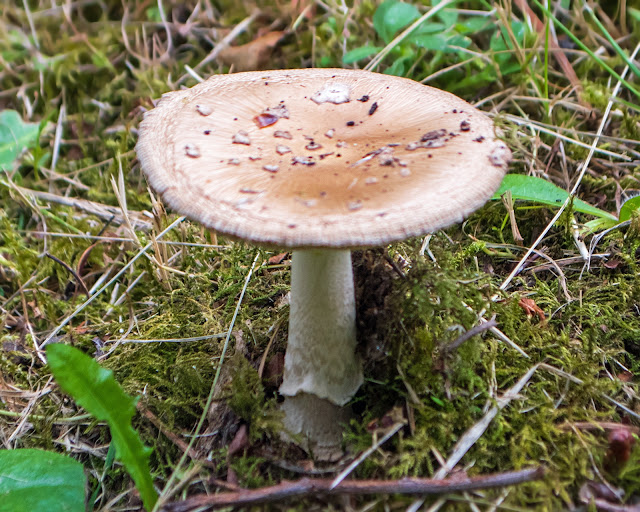It seems to be Amanita season. With the hot, dry weather, most fungi have gone into hiding; still there, underground, but waiting for rain before they push their fruiting bodies (what we know as mushrooms) out into the light again. Not the assorted Amanita species; even in open fields, bathed in sunlight, they're still to be found.
 |
| This one is in half-shade. |
Most Amanitas, whether they're the Fly Amanita, the Panther, or most others, can be identified by two characteristics; the "warts" or "fly-specks", remnants of the universal veil it wore as a youngster; and the volva, the other end of the same veil, showing as a ragged cup at the bottom of the stalk. Often this can only be seen by digging into the duff at the base. The mushroom may also wear a skirt-like partial veil remnant further up the stalk, as in the photo above.
 |
| Warts, partial veil ring, and hints of the volva beneath. |
 |
| Top view. |
This is where it gets tricky: the poisonous
Amanita, when still a button, disguises itself as a puffball, edible and delicious. Cut in half, the structure of stalk and cap appears; not a puffball.
 |
| This looked like a dusty puffball until I pulled away the moss around the base. And there's the volva. |
I used to eat mushrooms I found in the wild, especially puffballs. Not any more; the whole
Amanita tribe is extremely variable, and has often been mistaken for edible mushrooms. Better safe than sorry.
~~~~~~~~~~~~~~~~~~~~~~~~
Parece que ahora es la temporada de las Amanitas. Ahora que hace calor, y que ya no llueve, la mayoría de los hongos están escondidos bajo tierra, esperando a que vuelve el agua, cuando de vuelta sus cuerpos fructíferos — los que nosotros llamamos hongos, sin tomar en cuenta la mayor parte del hongo, que vive en la oscuridad — saltarán a la vista de nuevo.
Pero no se esconden las Amanita; siguen apareciendo aun en terrenos abiertos, expuestos a pleno sol.
Foto # 1: Amanita, en media sombra.
La mayoría de los Amanita spp., ya sea la muscaria (la matamoscas), la Pantera, o casi todas las otras, se pueden identificar por dos características: en primer lugar, los restos del velo universal que lo envolvía en su primera etapa de crecimiento; algunos dicen que parecen fragmentos de algodón; con la edad y la lluvia a veces desaparecen.
En la base del estipe aparece de nuevo este velo, ya en forma de una copita que envuelve la base. Muchas veces éste solamente se puede ver si se retrae la tierra alrededor de la base.
Y a veces, no siempre, también quedan fragmentos de un velo parcial, en forma de una falda alrededor del tallo, tal como se ve en las primeras dos fotos aquí.
Foto # 2: Las manchas, el velo parcial, y casi escondido, la volva.
Foto # 3: El mismo hongo, vista desde arriba.
Estos hongos, cuando apenas son botones, se pueden parecer a los hongos polveras. Y los Amanita son tóxicos, mientras que los hongos polveras se pueden comer y son deliciosos. Se ve la diferencia, cortándolos por la mitad; en el centro, si es Amanita, se ven los indicios del estipe y sombrero.
Foto # 4: Este botón parecía hongo polvera, con fragmentos de musgo, hasta que le quité el musgo que escondía el pie, destapando la volva.
Hace tiempo, yo comía muchos hongos salvajes, sobre todo los hongos polvera. Ya no: toda la tribu de los Amanita es variable, en forma y color, y muchas veces se ha confundido con hongos comestibles, con resultados a veces trágicos. Más vale prevenir ...





Just catching up on blogs after a long while away. Your's as endlessly fascinating s ever. I am in the French Alps this summer - nature here is so abundant, though I miss the sea!
ReplyDelete